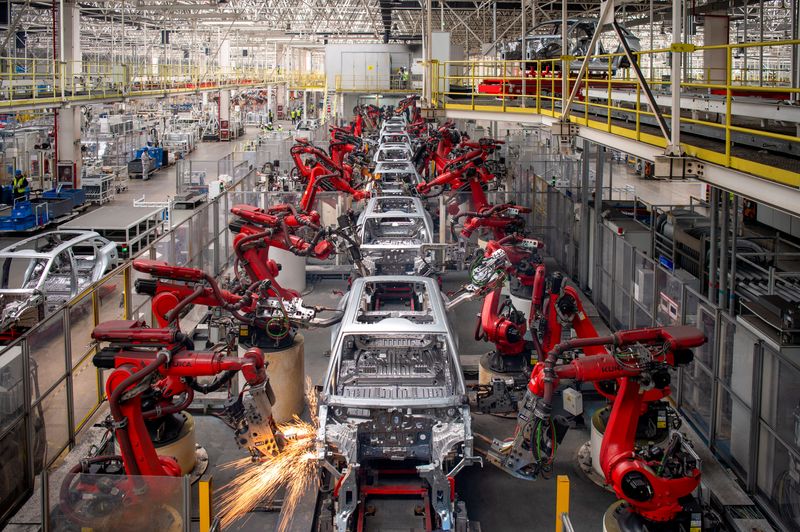
© Reuters. FILE PHOTO: Robotic arms assemble cars in the production line for Leapmotor’s electric vehicles at a factory in Jinhua, Zhejiang province, China, April 26, 2023. China Daily via REUTERS/File Photo
BEIJING (Reuters) -China’s manufacturing activity contracted for the fourth straight month in January, an official factory survey showed on Wednesday, suggesting the sprawling sector and the broader economy were struggling to regain momentum at the start of 2024.
The official purchasing managers’ index (PMI) rose to 49.2 in January from 49.0 in December, driven by a rise in output but still below the 50-mark separating growth from contraction. It was in line with a median forecast of 49.2 in a Reuters poll.
The data provides the first official snapshot of how the world’s No.2 economy has started off the new year after a shakier-than-expected post-COVID recovery.
The latest figure is also affected by the Lunar New Year which will fall on Feb. 10 this year, as factories may shut earlier and send workers back home ahead of the holiday.
“Economic momentum remained muted as the deflationary pressure persists,” said Zhiwei Zhang, chief economist at Pinpoint Asset Management, and expects China’s central bank to cut rates in the first half of the year to boost domestic demand.
January’s new orders sub-index was at 49.0, contracting for the fourth month, according to the NBS survey. Weak external demand also dragged on manufacturing activity, with the new export orders index registering at 47.2, contracting for the 10th straight month.
To spur growth, China’s central bank governor Pan Gongsheng unexpectedly announced a cut to banks’ reserve requirement ratio at a press conference last week. Authorities face a daunting task as they try to revitalise the economy in the face of a property downturn, local government debt risks, deflationary pressures and weak global demand.
The official non-manufacturing purchasing managers’ index (PMI), which includes services and construction, rose to 50.7 from 50.4 in December, the highest since September last year, according to the NBS.
The sub-index of services PMI returned to growth following two months of contraction, but construction PMI grew at a significantly slower pace.
The composite PMI, which includes manufacturing and services, was at a four-month high of 50.9 in January compared with 50.3 the previous month.
“It is not clear if the latest rise in the PMIs reflects a further improvement in January or simply the easing of sentiment effects that have been weighing on the surveys,” said Julian Evans-Pritchard, head of China economics at Capital Economics.
“Either way, it adds to evidence that growth momentum in China is in the midst of a renewed recovery, albeit one that remains on shaky foundations and is unlikely to be sustained once current policy support is pared back.”
The International Monetary Fund on Tuesday lifted China’s growth forecast this year to 4.6% from 4.2% in October, thanks to the significant fiscal support from the authorities and a less-severe-than-expected slowdown in the property sector.
China won’t release its 2024 growth target till March, but policy insiders expect Beijing to maintain a similar growth target to last year of around 5%.


